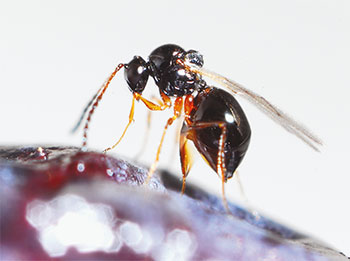Parasitic Wasp on the Hunt for Spotted Wing Drosophila
A parasitic wasp now being released by Oregon State University and USDA scientists isn’t expected to provide total control of the spotted wing drosophila, said Jana Lee, an entomologist with the USDA Agricultural Research Service in Corvallis. But its impact could be significant.
 |
Jana Lee, USDA Agricultural Research Service |
“Our hope is that it helps reduce background levels of spotted wing,” Lee said.
In a presentation at the 2022 Oregon Blueberry Field Day, Lee said she was excited to finally be releasing a parasitic wasp that researchers have been working on now for more than a decade.
“We started releases and we are excited,” she said. “Last year the area-wide project started, but it was the baseline year. So, we were just trapping and didn’t release it.
“This year we are actually releasing them,” Lee said.
Lee, who has been rearing the wasp, Ganaspis brasiliensis, at a clip of about a thousand a week of late, said the wasps are “rather high maintenance.”
“It has been a learning curve,” she said of efforts to rear the wasp.
The researchers are focusing releases on areas of high populations that aren’t currently being sprayed in an effort to provide the wasp, which targets SWD exclusively, plenty of food source.
 |
Image of Ganaspis brasiliensis. This image was imported from the Journal of Integrated Pest Management (2019) vol. 10 art. 13 where it has been published under the Open Government Licence. |
“We are making releases strategically,” she said. Researchers, for example, are releasing the wasp in areas with high densities of wild Himalayan blackberries, which are an attractive host for the SWD.
“With the wasps being released there, we hope they establish a population and then start to spread,” Lee said. Ultimately, the hope is that once significant populations of the wasps are established, they will move into blueberries and other crops susceptible to the tiny fruit fly when populations build up in the target crops.
The area-wide project will continue for at least one more year, Lee told the approximately 100 field day participants at the North Willamette Research and Extension Center.
Asked if the wasp presents a danger to other insects, Lee said no.
“This is one of the most host-specific wasps and is the one that has been approved,” she said. “There are other parasitic wasps that attack a wider range, but were not approved for this mass rearing and release.”
The wasp also is being released in Washington state, where researchers are targeting the SWD in cherries, and in California, where researchers are making releases in blackberries and raspberries, Lee said.
Spotted wing drosophila was first found in Oregon in 2009. It has since become one of the most significant pests of soft fruit crops, like cherries, peaches, strawberries, raspberries and blueberries.
Management of the SWD in the blueberry industry alone, costs growers $100 million a year nationwide, according to industry sources.
“This will have a huge impact,” said OSU Extension entomologist Vaugh Walton, who has been working with Lee on the project. “Spotted wing drosophila is very difficult to control. It’s got a very, very high reproduction rate with many generations per year. Because of that, when using pesticides, they have to be applied constantly, sometimes two or three times a week.”
Even reducing one or two sprays a year for the pest will result in significant savings for growers, Walton said.
“We think this is going to change things,” he said.
“We’ll never take down the entire fly population,” Walton added. “But as SWD increases, there is more food for the wasp.”
The wasp kills SWD by laying its eggs inside the insect. When the wasp hatches, its larva consumes the fruit fly.